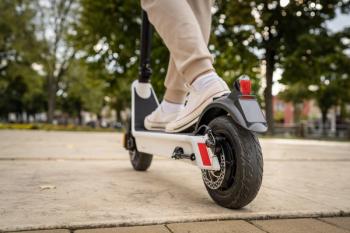
- Vol 37 No 4
- Volume 37
- Issue 4
Progressive plaque in a 9-year-old boy
Anxious parents present their healthy 9-year-old son for evaluation of a slowly enlarging plaque that began developing on his lower back 3 months ago. What's the diagnosis?
The case
Anxious parents present their healthy 9-year-old son for evaluation of a slowly enlarging plaque that began developing on his lower back 3 months ago.
Diagnosis: Morphea
Discussion
Morphea, also known as localized scleroderma, is an uncommon fibrosing disorder that is limited to the skin, subcutaneous tissues, underlying bone, and, rarely, the central nervous system. Morphea often initially appears as erythematous to violaceous patches and plaques during the early inflammatory phase. Over time, the centers of lesions become sclerotic and hypopigmented while the borders form a characteristic violaceous ring.1
In late stages, the damage from excess collagen deposition results in white or hyperpigmented sclerotic plaques that are hairless and anhidrotic.1 Many subtypes of morphea exist. However, the linear subtype is most common in the pediatric population aged 5 to 14 years and is characterized by linear indurated plaques on the trunk, limbs, or head.
Whereas the etiology of morphea is unknown, several factors are thought to play a role, including trauma/radiation, medications, infection, and autoimmunity.1 These triggers may contribute to initial vascular injury, resulting in recruitment of inflammatory cells. This process may lead to increased production of profibrotic cytokines, such as transforming growth factor-beta, and stimulate increased collagen production and decreased collagen destruction. The resulting excess collagen deposition leads to the clinical presentation of morphea.
Differential diagnosis
Morphea encompasses several subtypes that may appear morphologically distinct and require a variety of differential diagnoses. However, and most importantly, physicians must first distinguish morphea from systemic scleroderma. Unlike systemic sclerosis, morphea is not associated with the development of Raynaud phenomenon, sclerodactyly, nailfold capillary changes, multiorgan involvement, or the development of specific serum antibodies (anticentromere antibodies and anti-Scl-70 antibodies).1
Lichen sclerosus et atrophicus is a condition characterized by white, shiny, atrophic plaques that predominantly affect the anogenital region but occasionally can develop on the trunk and/or extremities. Lichen sclerosus and morphea may present simultaneously in the same patient and may have a common etiologic agent. Lipodermatosclerosis, or sclerosing panniculitis, can appear as a nontender sclerotic plaque, usually on the lower extremities. The condition is traditionally due to chronic venous insufficiency in older adults.
Management of morphea
Currently, there is no consensus regarding the treatment for morphea. The extent and severity of the involved lesion must be taken into consideration. Topical agents and ultraviolet phototherapy can be effective for superficial lesions, whereas systemic therapy, such as methotrexate, is required for subtypes with extension into deeper structures.2,3
Therapy with moderate and high-potency corticosteroids is the main topical treatment for morphea during the early inflammatory phase of the disease.3 Application should be restricted to a total of 3 months. Topical tacrolimus ointment also has been shown to improve morphea.
When morphea involves fascia, muscle, and bone, joint contractures and limb-length discrepancies are not uncommon and may necessitate involvement of physical and occupational therapy and consultation with Rheumatology, Orthopedics, and Podiatry.4
Patient outcome
The patient was treated with a high-potency topical steroid twice daily for 3 months. At follow-up, the plaque was flatter, soft, and asymptomatic, so the topical steroids were discontinued. Clinical monitoring was continued via the electronic record and the patient’s return visit in 6 months.
References:
1. Fett N, Werth VP. Update on morphea: part 1. Epidemiology, clinical presentation, and pathogenesis. J Am Acad Dermatology. 2011;64(2):217-228. doi:10.1016/j.jaad.2010.05.045
2. Pope E, Laxer RM. Diagnosis and management of morphea and lichen sclerosus and atrophicus in children. Pediatr Clin North Am. 2014;61(2):309-319. doi:10.1016/j.pcl.2013.11.006
3. Kreuter A. Localized scleroderma. Dermatol Ther. 2012;25(2):135-147. doi: 10.1111/j.1529-8019.2012.01479.x
4. Merlin E, Breton S, Fraitag S, et al. Fibrous arthropathy associated with morphea: a new cause of diffuse acquired joint contractures. Pediatrics. 2019;140(4):e20161899.
Articles in this issue
over 5 years ago
Toddler’s unusual oral trauma is troublingover 5 years ago
How to diagnose shoulder injuries in young athletesover 5 years ago
Vaping and electronic cigarette use in the pediatric populationover 5 years ago
SGA treatment raises risk of metabolic disturbancesover 5 years ago
Ondansetron is effective for acute migraineover 5 years ago
AAP issues recommendations for Williams syndromeover 5 years ago
COVID-19: Thoughts while circling the wagonsover 5 years ago
New food course builds healthy relationships with foodover 5 years ago
Hexavalent vaccine added to Vaccines for Children programover 5 years ago
Cool running water is best immediate treatment for burnsNewsletter
Access practical, evidence-based guidance to support better care for our youngest patients. Join our email list for the latest clinical updates.














